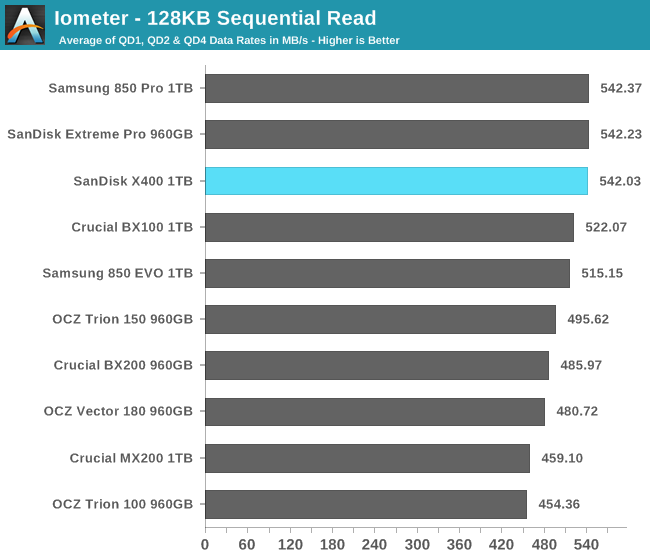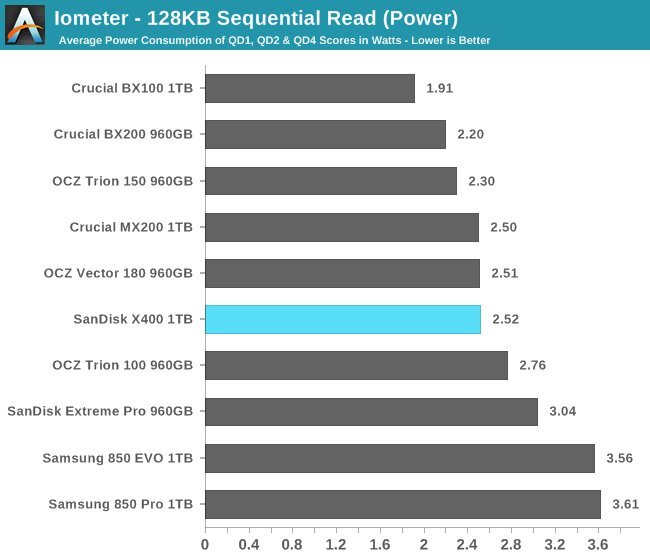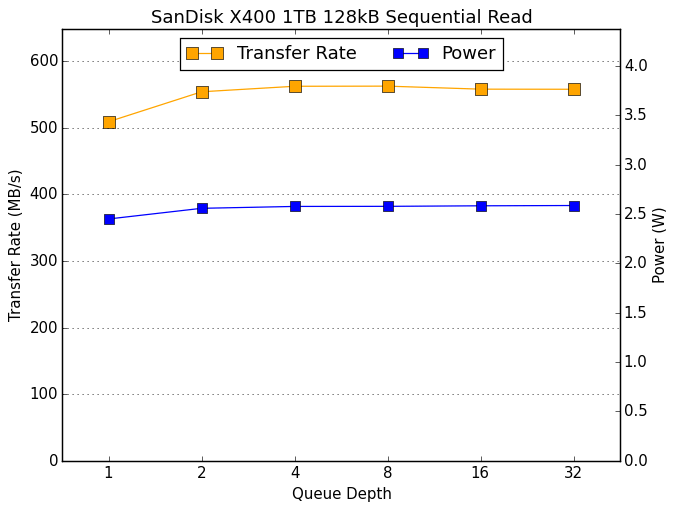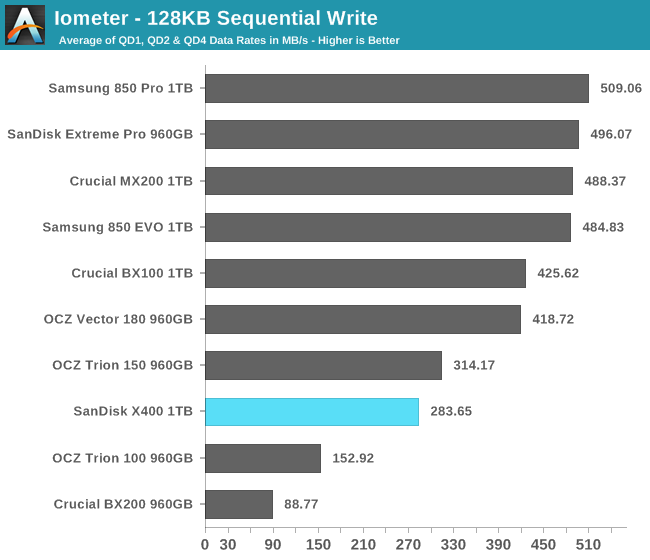The SanDisk X400 1TB SSD Review
by Billy Tallis on May 6, 2016 9:00 AM ESTSequential Read Performance
The sequential read test requests 128kB blocks and tests queue depths ranging from 1 to 32. The queue depth is doubled every three minutes, for a total test duration of 18 minutes. The test spans the entire drive, and the drive is filled before the test begins. The primary score we report is an average of performances at queue depths 1, 2 and 4, as client usage typically consists mostly of low queue depth operations.

The SanDisk X400 is in a three-way tie for first place for low queue depth sequential read speeds, with measurably better performance than any other TLC drive, even the Samsung 850 EVO.

The X400's power consumption is about average, but significantly better than the other two top performers. It's nowhere near the efficiency of the Crucial BX100, but for a TLC drive it's impressive.
 |
|||||||||
The SanDisk X400 is one of only four drives that delivers over 500MB/s at QD1, and it's the least power-hungry of that club. At higher queue depths many other drives are able to reach the same SATA speed limit and some do it with less power consumption than the X400.
Sequential Write Performance
The sequential write test writes 128kB blocks and tests queue depths ranging from 1 to 32. The queue depth is doubled every three minutes, for a total test duration of 18 minutes. The test spans the entire drive, and the drive is filled before the test begins. The primary score we report is an average of performances at queue depths 1, 2 and 4, as client usage typically consists mostly of low queue depth operations.

The sequential write speed of the SanDisk X400 is the second test on which it is clearly slower than another planar TLC drive: the OCZ Trion 150. Both are much faster than the other two planar TLC drives in this bunch, but are slower than the MLC drives by a similarly large margin.

The X400 draws the least power of any drive on this test, so at least it's still very efficient for a TLC drive.
 |
|||||||||
Sequential write performance and power consumption for the X400 are essentially constant across all queue depths, while the faster drives see at least some improvement from QD1 to QD2.










41 Comments
View All Comments
Chaitanya - Friday, May 6, 2016 - link
1TB capacity in M.2 Form factor is tempting.nathanddrews - Friday, May 6, 2016 - link
I like the $/GB, but there aren't enough GBs.Namisecond - Sunday, May 8, 2016 - link
Maybe you need to stop treating SSDs as bulk storage?dsumanik - Sunday, May 8, 2016 - link
Maybe you should go back to floppies.It's 2016 and there is no reason for magnetic drives to be alive. Yes yes, I know about cost per gig and all the stats you feel like googling and quoting to me to prove how smart you are, but the real truth is this: it's way more profitable to sell us 50 year old technology cuz dums dums will keep on buying.
Bring on xpoint, it'll help push traditional flash down into the bargain bin... And for u sir, Ii will gladly mail you my original dos 6.22 install disks if you simply shut the f**k up.
santeana - Monday, May 9, 2016 - link
LMAO! I wish there was a like button!+1
blakeatwork - Monday, May 9, 2016 - link
It's a process of how quickly do you need to access certain types of data. OS, programs and games all benefit from being on an SSD (assuming supporting architecture does not have any obvious bottlenecks). I'm not sure browsing photos from a recent vacation really provides the necessary strain on your I/O that requires an SSD :DMagnetic drives will stick around for quite a while, especially for Home/SMB NAS devices where the amount of storage is greater then the perceived need for super fast access, which is throttled by GbE network (or WiFi) anyways
bug77 - Tuesday, May 10, 2016 - link
Modern operating system do lots of stuff in the background, an AV may scan your drives from time to time. This is stuff that kills IO on a HDD and that barely registers on a SSD. So there are reason for moving away from HDDs... But yes, the HDD will stick around for a while, simply because of pricing.jordanclock - Saturday, July 2, 2016 - link
Good thing we just dump all old technology as soon as we find a replacement!edward1987 - Thursday, September 22, 2016 - link
1TB is quite out of my pocket £218 (http://www.span.com/product/SanDisk-X400-SSD-SD8SN... but 512GB I would not mind. If you have Qnap tvs-1282 server or similar - they have m.2 for caching or tiered storage. I can use for it in there.HollyDOL - Friday, May 6, 2016 - link
There is a mismatch in Specification table:1TiB (1024GB) should be 1TB(1000GB)
According to specs at https://www.sandisk.com/content/dam/sandisk-main/e...
putting 10^3n and 2^10n prefixes together is just incorrect anyway without correct recalculation...